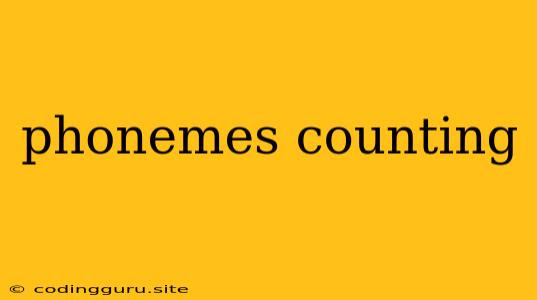Understanding and Counting Phonemes: A Guide for Language Learners and Linguists
Counting phonemes might seem like a daunting task, but it's a fundamental skill for anyone interested in understanding the intricacies of spoken language. Phonemes are the smallest units of sound that distinguish meaning in a language. They are the building blocks of words, and understanding them is essential for pronunciation, comprehension, and even language acquisition.
Why Count Phonemes?
Counting phonemes can be useful for various reasons:
- Language Learning: Identifying the number of phonemes in a language helps learners grasp the nuances of pronunciation. For example, English has approximately 44 phonemes, while Spanish has around 22.
- Linguistic Analysis: Phoneme counting is a crucial tool for linguists studying the structure and evolution of languages. It helps identify patterns and variations in sound systems across different languages.
- Speech Recognition Technology: Accurate phoneme counting is essential for developing speech recognition software, which relies on analyzing and interpreting speech sounds.
How to Count Phonemes
Counting phonemes requires a systematic approach:
- Identify the Minimal Pairs: Minimal pairs are words that differ by only one sound. For example, "cat" and "bat" are minimal pairs in English because they only differ in the initial consonant sound.
- Determine the Phoneme: The differing sounds in minimal pairs represent distinct phonemes.
- Avoid Redundant Counting: Be careful not to count the same phoneme twice. For example, the word "cat" has three phonemes: /k/, /æ/, and /t/. You should not count the /t/ phoneme twice just because it appears twice in the spelling.
Example: Counting Phonemes in English
Let's count the phonemes in the English sentence, "The cat sat on the mat."
- The: /ðə/ (2 phonemes)
- Cat: /kæt/ (3 phonemes)
- Sat: /sæt/ (3 phonemes)
- On: /ɒn/ (2 phonemes)
- The: /ðə/ (2 phonemes)
- Mat: /mæt/ (3 phonemes)
Therefore, the sentence "The cat sat on the mat" has 15 phonemes.
Challenges in Phoneme Counting
While the concept of phoneme counting might seem straightforward, it comes with its own set of challenges:
- Allophones: Allophones are variations of a phoneme. For example, the /t/ sound in "top" and "stop" are produced differently, but they represent the same phoneme. It's important to distinguish between allophones and phonemes to avoid overcounting.
- Dialectal Variations: Languages have different dialects, and each dialect might have slightly different pronunciations. This can make it difficult to establish a consistent phoneme count across all dialects.
- Phonetic Transcription: Accurately transcribing spoken language into phonetic symbols is a crucial step in phoneme counting. This requires a thorough understanding of phonetic notation and pronunciation rules.
Tips for Accurate Phoneme Counting
- Listen Carefully: Pay close attention to the sounds in words and sentences.
- Utilize Phonetic Charts: Familiarize yourself with phonetic charts to accurately represent sounds.
- Consider Context: The phonetic environment can influence how sounds are pronounced.
Conclusion
Counting phonemes is an essential skill for language learners and linguists alike. It helps us understand the building blocks of language, identify variations across languages, and even contribute to advancements in speech technology. Although phoneme counting can be complex, with careful attention to detail and a solid understanding of phonetic principles, anyone can master this skill.
